Konôpková Jana
Dendrobiology RG
Research staff
 Konôpková Jana, Ing., PhD.
Konôpková Jana, Ing., PhD.
Head of the Mlyňany Arboretum
Institute of Forest Ecology SAS
Vieska nad Žitavou 178
95152 Slepčany
phone: +421 37 633 4571
mobile: +421 911 999 847
e-mail: jana.konopkova@savba.sk
Research focus
- plant tissue cultures, in vitro propagation of ornamental plants, micropropagation,
- mineral nutrition of woody plants
- pharmacologically active compounds in plant tissue cultures
Education
- 2003 – PhD. (external form) in Agrochemistry and Plant Nutrition at the Department of Agrochemistry and Plant Nutrition, Faculty of Agrobiology and Food Resources, Slovak Agricultural University in Nitra
Thesis: Production, energy equivalent and nutrient content of selected woody plants - 1985 – Dipl. Ing. study in Food Science and Biochemistry at the Faculty of Chemical and Food Technology (before Faculty of Chemical Technology) , Slovak Technichal University in Bratislava
Research stays
2015 Institute of Experimental Botany, Academy of Sciences of the Czech Republik, Prague
2007 3rd Global Botanic Gardens Congress, Wuhan, China
2005 Institute of Dendrology, Polish Academy of Sciences, Kornik, Poland
Teaching experiences
2007-present Plant Biotechnologies in Mlyňany Arboretum IFE SAS for University of Constantine the Philosopher students
Scientific-organisational activities:
07/2014 – present Head of the Mlyňany Arboretum IFE SAS
10/2013 – 06/2014 Director of the Mlyňany Arboretum SAS
05/2009 – 10/2013 Deputy director of the Mlyňany Arboretum SAS
10/2008 – 03/2009 Director of the Mlyňany Arboretum SAS
05/2007 – 09/2013 Head of the Department of Dendrobiology, Mlyňany Arboretum SAS
09/2006 – 10/2013 Member of Scientific Board of the Mlyňany Arboretum SAS
05/2007 – 04/2013 Member of SAS Assembly
Recent projects (principal investigator)
2016 – 2019 VEGA 2/0072/16 Bioactive substancesin selected species of Magnolia genus
2011 – 2014 VEGA 2/0159/11 Adaptability of selected evergreen woody plants and their possible uses in garden and landscape architecture
2007 – 2009 VEGA 2/704/27 New technology in propagation of ornamental plants
2006 – 2009 APVV, LPP – 0096 Arboretum Mlyňany in education and training
List of my publications:
2023 |
|
Oravec, Adrián; Ferus, Peter; Košútová, Dominika; Konôpková, Jana Screening for drought resistance among ornamental maples (Acer sp.). A field experiment in juvenile plants Journal Article Dendrobiology, 89 , pp. 35–45, 2023, ISSN: 1641-1307. @article{Oravec_2023, title = {Screening for drought resistance among ornamental maples (Acer sp.). A field experiment in juvenile plants}, author = {Adrián Oravec and Peter Ferus and Dominika Košútová and Jana Konôpková}, url = {http://dx.doi.org/10.12657/denbio.089.004}, doi = {10.12657/denbio.089.004}, issn = {1641-1307}, year = {2023}, date = {2023-02-01}, journal = {Dendrobiology}, volume = {89}, pages = {35–45}, publisher = {Bogucki Wydawnictwo Naukowe}, keywords = {}, pubstate = {published}, tppubtype = {article} } | |
2022 |
|
Michalko, Jaroslav; Medo, Juraj; Ferus, Peter; Konôpková, Jana; Košútová, Dominika; Hot’ka, Peter; Barta, Marek Plants, 11 , pp. 417, 2022, ISSN: 2223-7747. @article{Michalko2022, title = {Changes of Endophytic Bacterial Community in Mature Leaves of Prunus laurocerasus L. during the Seasonal Transition from Winter Dormancy to Vegetative Growth}, author = {Jaroslav Michalko and Juraj Medo and Peter Ferus and Jana Konôpková and Dominika Košútová and Peter Hot’ka and Marek Barta}, doi = {10.3390/plants11030417}, issn = {2223-7747}, year = {2022}, date = {2022-02-03}, journal = {Plants}, volume = {11}, pages = {417}, abstract = {Diverse communities of bacterial endophytes inhabit plant tissues, and these bacteria play important roles for plant growth and health. Cherry laurel (Prunus laurocerasus L.) is a broadleaf evergreen shrub that is widely grown in temperate zones for its ornamental and medicinal properties, however virtually nothing is known about its associated bacterial community. In this study, we analysed the matured one-year-old leaves of this plant using Illumina-based 16S rRNA gene metabarcoding to reveal the community structure of endophytic bacteria and understand its shifts during the seasonal transition from winter dormancy to a spring vegetative state. The overall community was composed of four dominant phyla (Proteobacteria, Actinobacteria, Firmicutes, Bacteroidetes). Corynebacterium, Acinetobacter, and Chryseobacterium genera were the most prevalent bacteria, comprising 13.3%, 6.9%, and 6.8% of the amplicon sequence variants (ASVs), respectively. The ASV richness and diversity increased significantly in May as compared to other sampling months (February, March, and April). We observed high variation in the overall community structure of endophytic bacteria among collection dates. The variation was only reflected by a few core community members, suggesting that the changes of the endophytic community during winter/spring seasonal transition are mostly associated with the less abundant community members. We identified biomarker taxa for late winter, mid spring, and late spring collection dates. This study is the first one to report on the diversity and composition of bacterial endophytes in the leaves of cherry laurel and its shifts across the dormancy-to-vegetative seasonal transition.}, keywords = {}, pubstate = {published}, tppubtype = {article} } Diverse communities of bacterial endophytes inhabit plant tissues, and these bacteria play important roles for plant growth and health. Cherry laurel (Prunus laurocerasus L.) is a broadleaf evergreen shrub that is widely grown in temperate zones for its ornamental and medicinal properties, however virtually nothing is known about its associated bacterial community. In this study, we analysed the matured one-year-old leaves of this plant using Illumina-based 16S rRNA gene metabarcoding to reveal the community structure of endophytic bacteria and understand its shifts during the seasonal transition from winter dormancy to a spring vegetative state. The overall community was composed of four dominant phyla (Proteobacteria, Actinobacteria, Firmicutes, Bacteroidetes). Corynebacterium, Acinetobacter, and Chryseobacterium genera were the most prevalent bacteria, comprising 13.3%, 6.9%, and 6.8% of the amplicon sequence variants (ASVs), respectively. The ASV richness and diversity increased significantly in May as compared to other sampling months (February, March, and April). We observed high variation in the overall community structure of endophytic bacteria among collection dates. The variation was only reflected by a few core community members, suggesting that the changes of the endophytic community during winter/spring seasonal transition are mostly associated with the less abundant community members. We identified biomarker taxa for late winter, mid spring, and late spring collection dates. This study is the first one to report on the diversity and composition of bacterial endophytes in the leaves of cherry laurel and its shifts across the dormancy-to-vegetative seasonal transition. | |
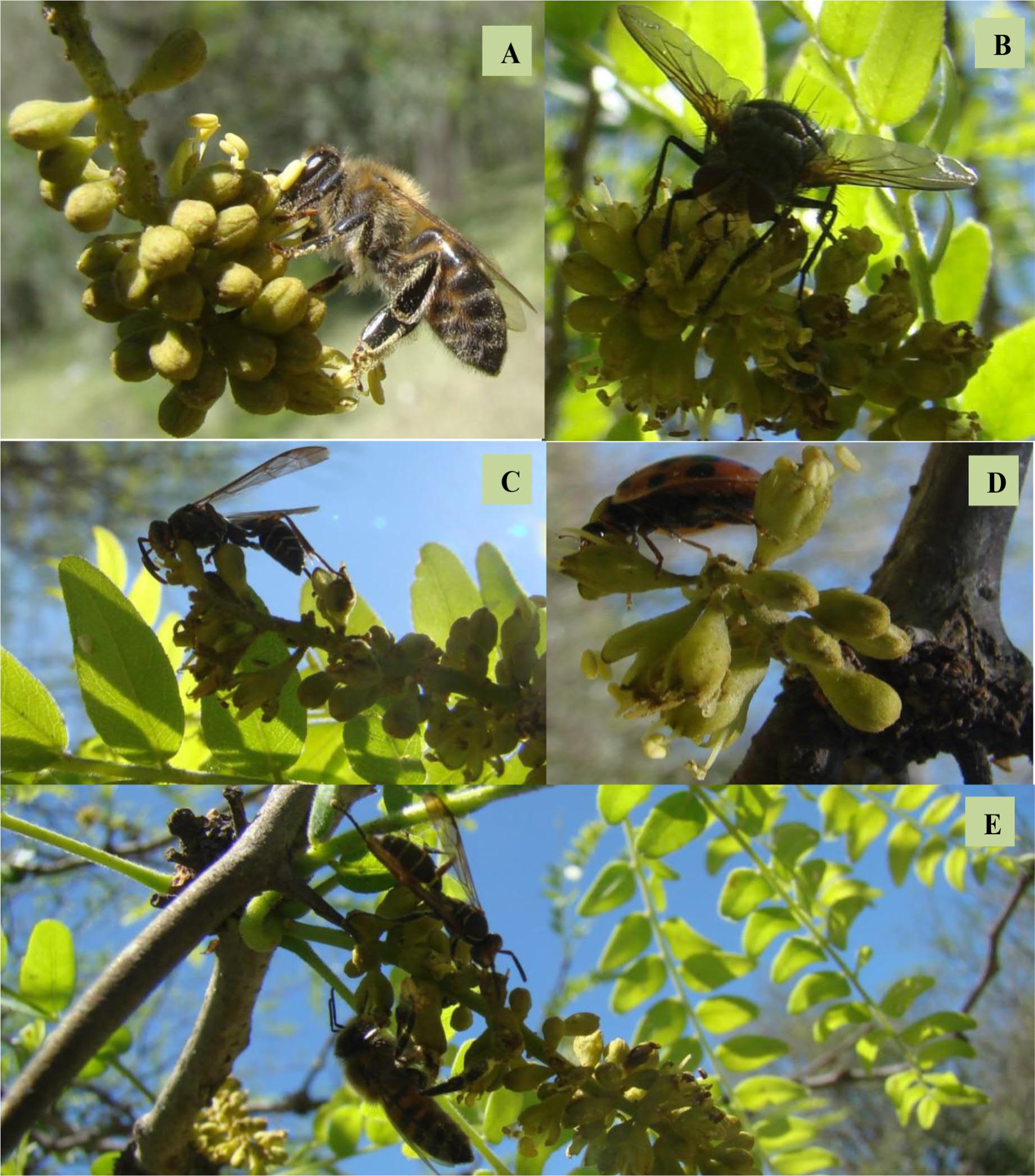 | Ruiz, Leda Silvera T; Amarilla, Leonardo D; Torres, Carolina; Košútová, Dominika; Konôpková, Jana; Ferus, Peter; Galetto, Leonardo Reproductive biology of the invasive Gleditsia triacanthos L. (Fabaceae) Journal Article Flora : morphology, distribution, functional ecology of plants, 288 , 2022, ISSN: ISSN 0367-2530. @article{Ruiz2022, title = {Reproductive biology of the invasive \textit{Gleditsia triacanthos} L. (Fabaceae)}, author = {Leda T. Silvera Ruiz and Leonardo D. Amarilla and Carolina Torres and Dominika Košútová and Jana Konôpková and Peter Ferus and Leonardo Galetto}, doi = {10.1016/j.flora.2022.152010}, issn = {ISSN 0367-2530}, year = {2022}, date = {2022-01-24}, journal = {Flora : morphology, distribution, functional ecology of plants}, volume = {288}, abstract = {Biotic invasions constitute a threat for natural communities, affecting ecological and evolutionary integrity of natural ecosystems. Gleditsia triacanthos is an invasive species in many regions of the world. In Argentina, its populations are expanding over native vegetation of different ecoregions. The aim of this work is to study the reproductive biology of the invasive honey locust, characterizing the reproductive individuals, the assemblage of pollinators, the pollination process, the compatibility system, and the reproductive success. Considering that G. triacanthos could be characterized as a novel invader in Argentina and plant-pollinator interactions could be important to facilitate plant invasions, we expect to find (a) an assembly of generalist floral visitors that promote pollination; (b) that fruits and seeds could be produced through self- (autogamy) or cross-pollination (mediated by pollinators); (c) that pollinators can increase reproductive success of exposed flowers compared to those experimentally isolated from pollinators. The studied populations (Córdoba Province, central Argentina) can be characterized as polygamous andro-dioecious, with a higher proportion of male individuals. Although honeybees were the most frequent pollinator, all floral visitors could be potential pollinators and the honey locust can be characterized as pollinator-generalist. G. triacanthos produces fruits and seeds by spontaneous self-pollination, but a higher reproductive success was observed after hand cross- or natural pollinations. Producing both self- and cross-pollinated seeds could be advantageous for this species during different stages of the invasion process. The generalist pollination system presented by G. triacanthos, the high production of pollen by male individuals compared to the individuals with perfect flowers, and the higher fruit and seed set by cross- or natural pollinated flowers are all traits favouring the invasion process. These reproductive traits could be considered when designing management strategies to control the expansion of this invasive species.}, keywords = {}, pubstate = {published}, tppubtype = {article} } Biotic invasions constitute a threat for natural communities, affecting ecological and evolutionary integrity of natural ecosystems. Gleditsia triacanthos is an invasive species in many regions of the world. In Argentina, its populations are expanding over native vegetation of different ecoregions. The aim of this work is to study the reproductive biology of the invasive honey locust, characterizing the reproductive individuals, the assemblage of pollinators, the pollination process, the compatibility system, and the reproductive success. Considering that G. triacanthos could be characterized as a novel invader in Argentina and plant-pollinator interactions could be important to facilitate plant invasions, we expect to find (a) an assembly of generalist floral visitors that promote pollination; (b) that fruits and seeds could be produced through self- (autogamy) or cross-pollination (mediated by pollinators); (c) that pollinators can increase reproductive success of exposed flowers compared to those experimentally isolated from pollinators. The studied populations (Córdoba Province, central Argentina) can be characterized as polygamous andro-dioecious, with a higher proportion of male individuals. Although honeybees were the most frequent pollinator, all floral visitors could be potential pollinators and the honey locust can be characterized as pollinator-generalist. G. triacanthos produces fruits and seeds by spontaneous self-pollination, but a higher reproductive success was observed after hand cross- or natural pollinations. Producing both self- and cross-pollinated seeds could be advantageous for this species during different stages of the invasion process. The generalist pollination system presented by G. triacanthos, the high production of pollen by male individuals compared to the individuals with perfect flowers, and the higher fruit and seed set by cross- or natural pollinated flowers are all traits favouring the invasion process. These reproductive traits could be considered when designing management strategies to control the expansion of this invasive species. |
2020 |
|
Ferus, Peter; Hoťka, Peter; Košútová, Dominika; Konôpková, Jana Invasions of alien woody plant taxa across a cluster of villages neighbouring the Mlyňany Arboretum (SW Slovakia) Journal Article Folia Oecologica, 47 (2), pp. 121-130, 2020. @article{Ferus2020, title = {Invasions of alien woody plant taxa across a cluster of villages neighbouring the Mlyňany Arboretum (SW Slovakia)}, author = {Peter Ferus and Peter Hoťka and Dominika Košútová and Jana Konôpková}, url = {http://ife.sk/wp-content/uploads/2020/09/foecol-2020-0005.pdf}, doi = {10.2478/foecol-2020-0014}, year = {2020}, date = {2020-11-24}, journal = {Folia Oecologica}, volume = {47}, number = {2}, pages = {121-130}, abstract = {Ornamental plantations in cities and particularly botanical gardens and arboreta are rich sources of alien flora. Mlyňany Arboretum, established in 1892, cultivates 1049 non-native woody plant species on the area of 67 ha. In this work we answered following questions: 1. How many taxa are spontaneously spreading in the arboretum and how is the spreading intensity related to their ecological demands and reproduction traits? 2. How many taxa appear behind the fence? 3. How far from the arboretum they can get? 4. Do private gardens and historical aristocratic park in the studied village cluster contribute to species escapes from culture? 5. Which from the widely spread taxa can represent future risk of invasiveness on the national level? We found that about one tenth of taxa spread across the arboretum (particularly Cotoneaster spp., Prunus laurocerasus, P. serotina and Quercus rubra) and number of their seedlings corresponded only with the mother plant number. Almost one third of these species left the arboretum and their seedlings were observed in distance up to 500 m from the village (mainly Mahonia aquifolium, P. serotina). Private gardens were a large source of Juglans regia seedlings, frequency of which decreased with the distance from villages (no species escaped from the historical park). Weed risk assessment revealed potential invasion danger only for Amorpha fruticosa.}, keywords = {}, pubstate = {published}, tppubtype = {article} } Ornamental plantations in cities and particularly botanical gardens and arboreta are rich sources of alien flora. Mlyňany Arboretum, established in 1892, cultivates 1049 non-native woody plant species on the area of 67 ha. In this work we answered following questions: 1. How many taxa are spontaneously spreading in the arboretum and how is the spreading intensity related to their ecological demands and reproduction traits? 2. How many taxa appear behind the fence? 3. How far from the arboretum they can get? 4. Do private gardens and historical aristocratic park in the studied village cluster contribute to species escapes from culture? 5. Which from the widely spread taxa can represent future risk of invasiveness on the national level? We found that about one tenth of taxa spread across the arboretum (particularly Cotoneaster spp., Prunus laurocerasus, P. serotina and Quercus rubra) and number of their seedlings corresponded only with the mother plant number. Almost one third of these species left the arboretum and their seedlings were observed in distance up to 500 m from the village (mainly Mahonia aquifolium, P. serotina). Private gardens were a large source of Juglans regia seedlings, frequency of which decreased with the distance from villages (no species escaped from the historical park). Weed risk assessment revealed potential invasion danger only for Amorpha fruticosa. | |
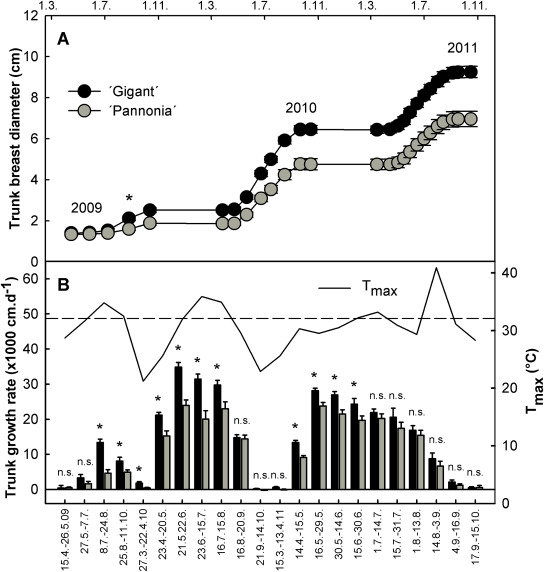 | Ferus, Peter; Hnilička, František; Hniličková, Helena; Kurjak, Daniel; Kmeť, Jaroslav; Otepka, Pavol; Gubiš, Jozef; Havrlentová, Michaela; Malbeck, Jiří; Konôpková, Jana Productivity and heat-stress tolerance in Canadian poplar (Populus × canadensis Moench) clones with different ecological optimum Journal Article Biomass and Bioenergy, 138 , 2020, ISSN: 0961-9534. @article{Ferus2020b, title = {Productivity and heat-stress tolerance in Canadian poplar (\textit{Populus × canadensis} Moench) clones with different ecological optimum}, author = {Peter Ferus and František Hnilička and Helena Hniličková and Daniel Kurjak and Jaroslav Kmeť and Pavol Otepka and Jozef Gubiš and Michaela Havrlentová and Jiří Malbeck and Jana Konôpková}, doi = {10.1016/j.biombioe.2020.105605}, issn = {0961-9534}, year = {2020}, date = {2020-07-01}, journal = {Biomass and Bioenergy}, volume = {138}, abstract = {Cultivation of fast growing poplar (Populus sp.) clones represents an effective means for reaching the 2020 target of the EU-28 renewable energy production. However, considering the continuous climate change, their growth can be markedly affected by summer heat stress episodes in Slovakia. Therefore, in this work two Canadian poplar (Populus × canadensis Moench) clones of different ecological optimum, ‘Gigant' and ‘Pannonia', were investigated in respect of productivity and heat stress tolerance. After three-year cultivation, tree height in the clone ‘Gigant' was 8.9 m, breast trunk diameter 9.3 cm and trunk volume 0.021 m3 compared to 7.9 m, 7.0 cm and 0.012 m3 in clone ‘Pannonia' (despite of relatively more stable trunk growth rate in summer). Trunks of the latter clone contained 12% bark (vs. 10% in ‘Gigant'), 1.5% ash in the wood (vs. 3%) and showed significantly larger wood density (440 vs. 380 kg m−3) but lower wood free energy content (14.5 vs. 16 MJ kg−1). Both of clones were proved to be diploids (2x). Clone ‘Pannonia' exhibited larger heat stress tolerance, as tested in leaves of different developmental stage exposed to 40 °C using chlorophyll fluorescence technique (decreasing from mature to juvenile leaves), lower specific leaf area and higher leaf carotenoid and cytokinin (particularly BAP derivatives) concentration. In spite of lower heat stress tolerance and higher ash content, clone ‘Gigant' showed larger productivity than clone ‘Pannonia', suggesting potential of the latter for cultivation in much more stressful conditions.}, keywords = {}, pubstate = {published}, tppubtype = {article} } Cultivation of fast growing poplar (Populus sp.) clones represents an effective means for reaching the 2020 target of the EU-28 renewable energy production. However, considering the continuous climate change, their growth can be markedly affected by summer heat stress episodes in Slovakia. Therefore, in this work two Canadian poplar (Populus × canadensis Moench) clones of different ecological optimum, ‘Gigant' and ‘Pannonia', were investigated in respect of productivity and heat stress tolerance. After three-year cultivation, tree height in the clone ‘Gigant' was 8.9 m, breast trunk diameter 9.3 cm and trunk volume 0.021 m3 compared to 7.9 m, 7.0 cm and 0.012 m3 in clone ‘Pannonia' (despite of relatively more stable trunk growth rate in summer). Trunks of the latter clone contained 12% bark (vs. 10% in ‘Gigant'), 1.5% ash in the wood (vs. 3%) and showed significantly larger wood density (440 vs. 380 kg m−3) but lower wood free energy content (14.5 vs. 16 MJ kg−1). Both of clones were proved to be diploids (2x). Clone ‘Pannonia' exhibited larger heat stress tolerance, as tested in leaves of different developmental stage exposed to 40 °C using chlorophyll fluorescence technique (decreasing from mature to juvenile leaves), lower specific leaf area and higher leaf carotenoid and cytokinin (particularly BAP derivatives) concentration. In spite of lower heat stress tolerance and higher ash content, clone ‘Gigant' showed larger productivity than clone ‘Pannonia', suggesting potential of the latter for cultivation in much more stressful conditions. |
Ferus, Peter; Bošiaková, Dominika; Konôpková, Jana; Hoťka, Peter Diverse strategies of rhododendron (Rhododendron sp.) genotypes in the water shortage management Journal Article Acta Scientiarum Polonorum. Hortorum Cultus, 19 (3), pp. 159-165, 2020, ISBN: 1644-0692. @article{Ferus2020d, title = {Diverse strategies of rhododendron (Rhododendron sp.) genotypes in the water shortage management}, author = {Peter Ferus and Dominika Bošiaková and Jana Konôpková and Peter Hoťka }, doi = {10.24326/asphc.2020.3.14}, isbn = {1644-0692}, year = {2020}, date = {2020-06-29}, journal = {Acta Scientiarum Polonorum. Hortorum Cultus}, volume = {19}, number = {3}, pages = {159-165}, abstract = {Rhododendrons in numerous gardens in Central Europe are frequently endangered by adverse summer drought periods associated with the climate change. Therefore, in this work drought-resistance strategies in recent genotypes of these highly aesthetic shrubs were investigated. Dehydrated Rhododendron groenlandicum ‘Helma’, R. obtusum ‘Michiko’ and R. hybridum ‘Polarnacht’ showed high initial stomatal conductances (gS), after few days steeply falling to the stable minimum at ca. 20, 85 and 70% leaf relative water content (RWC), respectively. Except of ‘Polarnacht’, they had relatively large specific leaf area and ‘Michiko’ also free proline accumulation. On the other hand, R. repens ‘Scarlet Wonder’ and R. hybridum ‘Red Jack’ started with half gS values, continuously declining 1.5–2 fold longer compared to the first group of genotypes (RWC of ca. 60 and 75%, respectively). Both produced relatively thick leaves but did not show any osmotic adjustment. Among observed drought-resistance strategies, lower and longer period active transpiration with stomata sensitive to the water loss, as found in R. repens ‘Scarlet Wonder’ and R. × hybridum ‘Red Jack’, were accepted as the most effective for drought-affected rhododendron plantations.}, keywords = {}, pubstate = {published}, tppubtype = {article} } Rhododendrons in numerous gardens in Central Europe are frequently endangered by adverse summer drought periods associated with the climate change. Therefore, in this work drought-resistance strategies in recent genotypes of these highly aesthetic shrubs were investigated. Dehydrated Rhododendron groenlandicum ‘Helma’, R. obtusum ‘Michiko’ and R. hybridum ‘Polarnacht’ showed high initial stomatal conductances (gS), after few days steeply falling to the stable minimum at ca. 20, 85 and 70% leaf relative water content (RWC), respectively. Except of ‘Polarnacht’, they had relatively large specific leaf area and ‘Michiko’ also free proline accumulation. On the other hand, R. repens ‘Scarlet Wonder’ and R. hybridum ‘Red Jack’ started with half gS values, continuously declining 1.5–2 fold longer compared to the first group of genotypes (RWC of ca. 60 and 75%, respectively). Both produced relatively thick leaves but did not show any osmotic adjustment. Among observed drought-resistance strategies, lower and longer period active transpiration with stomata sensitive to the water loss, as found in R. repens ‘Scarlet Wonder’ and R. × hybridum ‘Red Jack’, were accepted as the most effective for drought-affected rhododendron plantations. | |
Konôpková, Jana; Košútová, Dominika; Ferus, Peter Genotype-specific requirements for in vitro culture initiation and multiplication of Magnolia taxa Journal Article Folia Oecologica, 47 (1), pp. 34-44, 2020, ISSN: 1336-5266. @article{Konôpková2020, title = {Genotype-specific requirements for in vitro culture initiation and multiplication of Magnolia taxa}, author = {Jana Konôpková and Dominika Košútová and Peter Ferus}, url = {http://ife.sk/wp-content/uploads/2016/10/foecol-2020-0005.pdf}, doi = {10.2478/foecol-2020-0005}, issn = {1336-5266}, year = {2020}, date = {2020-04-30}, journal = {Folia Oecologica}, volume = {47}, number = {1}, pages = {34-44}, abstract = {The influence of basal media composition, concentration of plant growth regulators (PGRs), and the developmental stage of primary explants (dormancy, stage of bud opening and fruit ripening) on the initiation phase of nine Magnolia genotypes, including M. stellata /Sieb. & Zucc./Maxim., M. × soulangeana 'Rustica Rubra', M. denudata Desr., M. × soulangeana 'Alexandrina', M. liliiflora Desr., M. officinalis var. biloba Rehd. & Wils., M. salicifolia Maxim., M. × soulangeana 'Lennei', and M. kobus DC, was evaluated. The highest efficiency of primary culture initiation of seven Magnolia genotypes (except for M. liliiflora and M. salicifolia) was achieved from primary explants collected in the bud opening stage. A high positive correlation was found between total tannins and efficiency of the primary culture initiation at the fruit ripening stage (r = 0.833). Standardi and Catalano medium (S2) with 0.5 mg l–1 of 6-benzylaminopurine (BAP) was the most appropriate for multiplication of M. × soulangeana 'Alexandrina', whereas tissue cultures of M. × soulangeana 'Lennei' proliferated and grew better on S2 medium with 1.0 mg l–1 of BAP and 1.0 g l–1 of polyvinylpyrrolidone. The requirements for the composition of basal media and concentration of PGRs in the initiation and multiplication stages of micropropagation of various Magnolia species and cultivars are genotype-specific.}, keywords = {}, pubstate = {published}, tppubtype = {article} } The influence of basal media composition, concentration of plant growth regulators (PGRs), and the developmental stage of primary explants (dormancy, stage of bud opening and fruit ripening) on the initiation phase of nine Magnolia genotypes, including M. stellata /Sieb. & Zucc./Maxim., M. × soulangeana 'Rustica Rubra', M. denudata Desr., M. × soulangeana 'Alexandrina', M. liliiflora Desr., M. officinalis var. biloba Rehd. & Wils., M. salicifolia Maxim., M. × soulangeana 'Lennei', and M. kobus DC, was evaluated. The highest efficiency of primary culture initiation of seven Magnolia genotypes (except for M. liliiflora and M. salicifolia) was achieved from primary explants collected in the bud opening stage. A high positive correlation was found between total tannins and efficiency of the primary culture initiation at the fruit ripening stage (r = 0.833). Standardi and Catalano medium (S2) with 0.5 mg l–1 of 6-benzylaminopurine (BAP) was the most appropriate for multiplication of M. × soulangeana 'Alexandrina', whereas tissue cultures of M. × soulangeana 'Lennei' proliferated and grew better on S2 medium with 1.0 mg l–1 of BAP and 1.0 g l–1 of polyvinylpyrrolidone. The requirements for the composition of basal media and concentration of PGRs in the initiation and multiplication stages of micropropagation of various Magnolia species and cultivars are genotype-specific. | |
Ferus, Peter; Menčik, Karolina; Konôpková, Jana Allelopathic potential of Juglans nigra L. to control the invasive tree-of-heaven (Ailanthus altissima (Mill.) Swingle) Journal Article Allelopathy Journal, 49 (2), pp. 177-188, 2020, ISSN: 0971-4693. @article{Ferus2020c, title = {Allelopathic potential of \textit{Juglans nigra} L. to control the invasive tree-of-heaven (\textit{Ailanthus altissima} (Mill.) Swingle)}, author = {Peter Ferus and Karolina Menčik and Jana Konôpková }, doi = {10.26651/allelo.j/2020-49-2-1263}, issn = {0971-4693}, year = {2020}, date = {2020-01-01}, journal = {Allelopathy Journal}, volume = {49}, number = {2}, pages = {177-188}, keywords = {}, pubstate = {published}, tppubtype = {article} } | |
2019 |
|
Ferus, Peter; Bošiaková, Dominika; Konôpková, Jana; Hoťka, Peter; Kósa, Géza; Melnykova, Nataliya; Kots, Segiy Allelopathic interactions of invasive black locust (Robinia pseudoacacia L.) with secondary aliens: the physiological background Journal Article Acta Physiologiae Plantarum, 41 (11), 2019, ISSN: 0137-5881. @article{Ferus2019b, title = {Allelopathic interactions of invasive black locust (\textit{Robinia pseudoacacia} L.) with secondary aliens: the physiological background}, author = {Peter Ferus and Dominika Bošiaková and Jana Konôpková and Peter Hoťka and Géza Kósa and Nataliya Melnykova and Segiy Kots }, doi = {10.1007/s11738-019-2974-y}, issn = {0137-5881}, year = {2019}, date = {2019-11-09}, journal = {Acta Physiologiae Plantarum}, volume = {41}, number = {11}, abstract = {Despite of numerous benefits, black locust (Robinia pseudoacacia L.) is an invasive tree species in Slovakia and Hungary. Recently, secondary local invasions of black locust plantations by black cherry (Prunus serotina Ehrh.) and common hackberry (Celtis occidentalis L.) have been observed in these countries. In this study, we describe these unique tree-to-tree interactions directly in the field as well as simulated in the laboratory (1% water extracts from leaves and twigs applied on leaf and soil). In the field, we observed no effect on tree height and trunk diameter as well as leaf metabolic parameters caused by black cherry. However, the laboratory experiment showed a reduction in nodulation, and thus N fixation rate per plant, which did not mirror in the shoot and root dry matter (DM) production. On the other hand, common hackberry significantly affected tree height as well as leaf amino acid and total nitrogen concentration, but not the content of soluble sugars and hydrogen peroxide in the field. The laboratory experiment revealed significant reductions in nodulation, N fixation rate per plant, shoot and root DM and leaf hydrogen peroxide, nevertheless, a noticeable soluble protein accumulation. Thus, we can conclude that common hackberry, but not black cherry, can effectively suppress black locust N metabolism and growth.}, keywords = {}, pubstate = {published}, tppubtype = {article} } Despite of numerous benefits, black locust (Robinia pseudoacacia L.) is an invasive tree species in Slovakia and Hungary. Recently, secondary local invasions of black locust plantations by black cherry (Prunus serotina Ehrh.) and common hackberry (Celtis occidentalis L.) have been observed in these countries. In this study, we describe these unique tree-to-tree interactions directly in the field as well as simulated in the laboratory (1% water extracts from leaves and twigs applied on leaf and soil). In the field, we observed no effect on tree height and trunk diameter as well as leaf metabolic parameters caused by black cherry. However, the laboratory experiment showed a reduction in nodulation, and thus N fixation rate per plant, which did not mirror in the shoot and root dry matter (DM) production. On the other hand, common hackberry significantly affected tree height as well as leaf amino acid and total nitrogen concentration, but not the content of soluble sugars and hydrogen peroxide in the field. The laboratory experiment revealed significant reductions in nodulation, N fixation rate per plant, shoot and root DM and leaf hydrogen peroxide, nevertheless, a noticeable soluble protein accumulation. Thus, we can conclude that common hackberry, but not black cherry, can effectively suppress black locust N metabolism and growth. | |
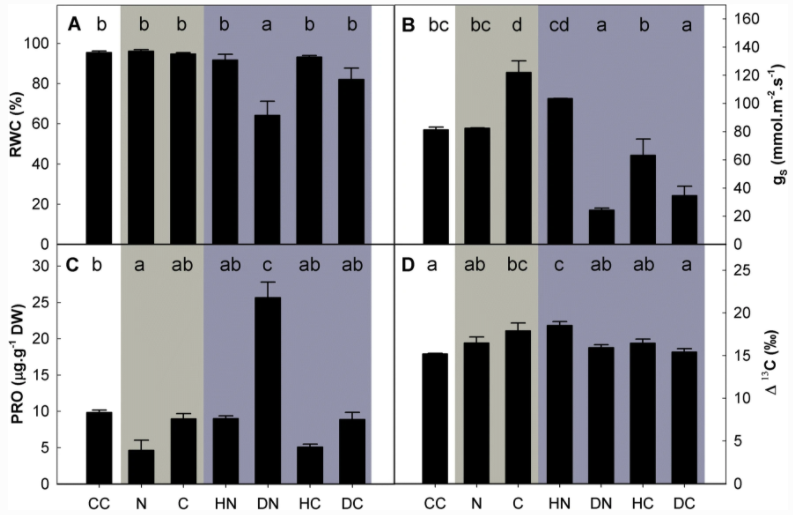 | Ferus, Peter; Barta, Marek; Konôpková, Jana Endophytic fungus Beauveria bassiana can enhance drought tolerance in red oak seedlings Journal Article Trees-Structure and Function, 33 (4), pp. 1179–1186, 2019, ISSN: 0931-1890. @article{Ferus2019, title = {Endophytic fungus \textit{Beauveria bassiana} can enhance drought tolerance in red oak seedlings}, author = {Peter Ferus and Marek Barta and Jana Konôpková }, doi = {10.1007/s00468-019-01854-1}, issn = {0931-1890}, year = {2019}, date = {2019-05-04}, journal = {Trees-Structure and Function}, volume = {33}, number = {4}, pages = {1179–1186}, abstract = {Endophytic fungi are known to be active in the plant environmental stress alleviation. In this work, we proved the ability of endophytic Beauveria bassiana, which is almost exclusively treated as an entomopathogenic fungus, in mitigating drought stress in dehydrated red oak (Quercus rubra L.) seedlings. Despite small differences between experiments, in general, leaf relative water content and stomatal conductance were less reduced (ca. 50% and 15%, respectively), free proline did not accumulate over the control level, carbon isotope 13C discrimination/water use efficiency was not affected and root growth was stimulated at a similar plant transpiration area in the endophyte-colonised individuals. Regression analysis revealed that the root growth stimulation provided by the fungus under drought had the most important effect on their water status.}, keywords = {}, pubstate = {published}, tppubtype = {article} } Endophytic fungi are known to be active in the plant environmental stress alleviation. In this work, we proved the ability of endophytic Beauveria bassiana, which is almost exclusively treated as an entomopathogenic fungus, in mitigating drought stress in dehydrated red oak (Quercus rubra L.) seedlings. Despite small differences between experiments, in general, leaf relative water content and stomatal conductance were less reduced (ca. 50% and 15%, respectively), free proline did not accumulate over the control level, carbon isotope 13C discrimination/water use efficiency was not affected and root growth was stimulated at a similar plant transpiration area in the endophyte-colonised individuals. Regression analysis revealed that the root growth stimulation provided by the fungus under drought had the most important effect on their water status. |
2017 |
|
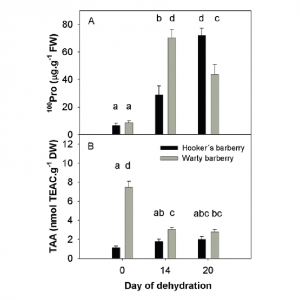 | Ferus, P; Bošiaková, D; Konôpková, J; Hoťka, P; Keet, J H Hooker’s or warty barberry? Physiological background analysis for choosing the right one into ornamental plantations endangered by drought. Journal Article Acta Universitatis Agriculturae et Silviculturae Mendelianae Brunensis, 65 (2), pp. 411-418, 2017. @article{Ferus2017, title = {Hooker’s or warty barberry? Physiological background analysis for choosing the right one into ornamental plantations endangered by drought.}, author = {P. Ferus and D. Bošiaková and J. Konôpková and P. Hoťka and J.H. Keet}, url = {https://acta.mendelu.cz/65/2/0411/}, doi = {https://doi.org/10.11118/actaun201765020411}, year = {2017}, date = {2017-01-01}, journal = {Acta Universitatis Agriculturae et Silviculturae Mendelianae Brunensis}, volume = {65}, number = {2}, pages = {411-418}, keywords = {}, pubstate = {published}, tppubtype = {article} } |
 | Ferus, P; Hoťka, P; Konôpková, J Drought and frost tolerance in rhododendron collection of the Mlyňany Arboretum (Slovakia): a screening for future climate Journal Article Folia Oecologica, 44 (2), pp. 87-95, 2017, ISBN: 1336-5266. @article{Ferus2017b, title = {Drought and frost tolerance in rhododendron collection of the Mlyňany Arboretum (Slovakia): a screening for future climate}, author = {P. Ferus and P. Hoťka and J. Konôpková}, url = {http://ife.sk/wp-content/uploads/2016/10/foecol-2017-0004-1.pdf}, doi = {10.1515/foecol-2017-0011}, isbn = {1336-5266}, year = {2017}, date = {2017-01-01}, journal = {Folia Oecologica}, volume = {44}, number = {2}, pages = {87-95}, abstract = {Rhododendrons are jewels of the Mlyňany Arboretum, Institute of Forest Ecology of the Slovak Academy of Sciences (IFE SAS). Blossoming in May, they attract thousands of visitors. But recently these woody plants have much suffered from climatic extremes such as summer droughts and winter frosts, associated with the advancing climate change. To assess the rhododendron collection´s stability, its drought and frost injury level were tested in field, in summer 2015 and winter 2017, respectively. The tested parameters were: leaf wilting and electrolyte leakage combined with shrub leaf area, insolation level and overall health state. We found that the drought effect was strong or very strong in only ca. 30% rhododendron species and ca. 10% rhododendron cultivars, and that around 60% shrubs showed no or only moderate symptoms of water deficit. The drought injury level was only associated with the genotype. The most tolerant / sensitive genotypes, commonly occurring in the park, were: R. catawbiense, R. ponticum, R. smirnowii, cv. ´Boursault´, cv. ´Cunningham´s White´ and cv. ´Purpureum Elegans´ / R. fortunei and cv. ´Tamarindos´. On the other hand, the most frequent response to frost in the observed rhododendron genotypes was moderate injury (28 and 37% for species and cultivars, respectively), nevertheless more than 18% species and almost 6% cultivars exhibited strong frost damage. Despite absence of significant differences in the factor-response between the species, we may suggest this decreasing sequence of the genotypes ordered according to their frost resistance: genotypes: cv. ´Cunningham´s White´ > R. decorum > R. fortunei and cv. ´Duke of York´ > R. smirnowii > cvs. ´Purpureum Elegans´and ´Tamarindos´ > R. macrophyllum and cv. ´Nova Zembla´ > R. catawbiense > R. ponticum. These results have been compared with similar works in rhododendron species/cultivars as well as suggested species drought/frost tolerance derived from climatic conditions in the area of their natural distribution.}, keywords = {}, pubstate = {published}, tppubtype = {article} } Rhododendrons are jewels of the Mlyňany Arboretum, Institute of Forest Ecology of the Slovak Academy of Sciences (IFE SAS). Blossoming in May, they attract thousands of visitors. But recently these woody plants have much suffered from climatic extremes such as summer droughts and winter frosts, associated with the advancing climate change. To assess the rhododendron collection´s stability, its drought and frost injury level were tested in field, in summer 2015 and winter 2017, respectively. The tested parameters were: leaf wilting and electrolyte leakage combined with shrub leaf area, insolation level and overall health state. We found that the drought effect was strong or very strong in only ca. 30% rhododendron species and ca. 10% rhododendron cultivars, and that around 60% shrubs showed no or only moderate symptoms of water deficit. The drought injury level was only associated with the genotype. The most tolerant / sensitive genotypes, commonly occurring in the park, were: R. catawbiense, R. ponticum, R. smirnowii, cv. ´Boursault´, cv. ´Cunningham´s White´ and cv. ´Purpureum Elegans´ / R. fortunei and cv. ´Tamarindos´. On the other hand, the most frequent response to frost in the observed rhododendron genotypes was moderate injury (28 and 37% for species and cultivars, respectively), nevertheless more than 18% species and almost 6% cultivars exhibited strong frost damage. Despite absence of significant differences in the factor-response between the species, we may suggest this decreasing sequence of the genotypes ordered according to their frost resistance: genotypes: cv. ´Cunningham´s White´ > R. decorum > R. fortunei and cv. ´Duke of York´ > R. smirnowii > cvs. ´Purpureum Elegans´and ´Tamarindos´ > R. macrophyllum and cv. ´Nova Zembla´ > R. catawbiense > R. ponticum. These results have been compared with similar works in rhododendron species/cultivars as well as suggested species drought/frost tolerance derived from climatic conditions in the area of their natural distribution. |
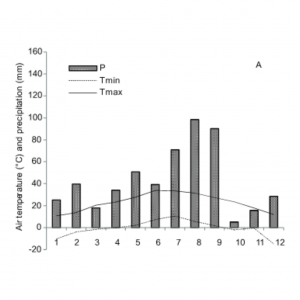 | Ferus, P; Konôpková, J; Bošiaková, D; Hoťka, P Effective rhododendron propagation through stem cuttings Journal Article Journal of Applied Horticulture, 19 (3), pp. 226-229, 2017, ISBN: 1336-5266. @article{Ferus2017d, title = {Effective rhododendron propagation through stem cuttings}, author = {P. Ferus and J. Konôpková and D. Bošiaková and P. Hoťka}, isbn = {1336-5266}, year = {2017}, date = {2017-01-01}, journal = {Journal of Applied Horticulture}, volume = {19}, number = {3}, pages = {226-229}, keywords = {}, pubstate = {published}, tppubtype = {article} } |
2015 |
|
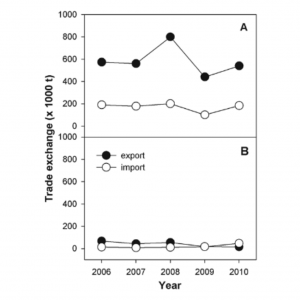 | Ferus, P; Sirbu, C; Eliáš, Jun P; Konôpková, J; Ďurišová, Ľ; Samuil, C; Oprea, A Reciprocal contamination by invasive plants: analysis of trade exchange between Slovakia and Romania Journal Article Biologia, 70 (7), pp. 893–904, 2015. @article{P.2015, title = {Reciprocal contamination by invasive plants: analysis of trade exchange between Slovakia and Romania}, author = {P. Ferus and C. Sirbu and P. Jun Eliáš and J. Konôpková and Ľ. Ďurišová and C. Samuil and A. Oprea}, url = {https://www.degruyter.com/view/j/biolog.2015.70.issue-7/biolog-2015-0102/biolog-2015-0102.xml}, year = {2015}, date = {2015-08-25}, journal = {Biologia}, volume = {70}, number = {7}, pages = {893–904}, keywords = {}, pubstate = {published}, tppubtype = {article} } |
2013 |
|
 | Ferus, P; Barta, M; Konôpková, J; Turčeková, S; Maňka, P; Bibeň, T Diversity in honey locust (Gleditsia triacanthos L.) seed traits across Danube basin Journal Article Folia Oecologica, 40 (2), pp. 163-169, 2013, ISSN: 1336-5266. @article{Ferus2013c, title = {Diversity in honey locust (Gleditsia triacanthos L.) seed traits across Danube basin}, author = {P. Ferus and M. Barta and J. Konôpková and S. Turčeková and P. Maňka and T. Bibeň}, url = {http://ife.sk/wp-content/uploads/2016/10/Ferus.pdf}, issn = {1336-5266}, year = {2013}, date = {2013-01-01}, journal = {Folia Oecologica}, volume = {40}, number = {2}, pages = {163-169}, abstract = {Honey locust (Gleditsia triacanthos L.), in the past planted as ornamental, technical or forest tree, is presently considered as casually invasive tree in Danube basin. Since plant invasiveness is usually tightly associated with its reproduction biology, in this work we focused on characterization of seeds from honey locust populations across this area. Analysing seed coat colour, thousand seeds weight (TSW), seed projection area, seed thickness, percentage of germinated seeds and their germination energy, as well as portion of seeds infested by honey locust seed beetle (Megabruchidius tonkineus), consumed part of seeds and their germination ability in relation to seed characteristics, local temperature means and precipitation sums during vegetation period, we came to the following conclusions: seed coat colour diversity decreases with geographical latitude; TSW, seed projection area and thickness were negatively correlated to mean temperature and positively to precipitation sum; between percentage of naturally germinated seeds and TSW as well as seed thickness we found positive correlations; germination energy showed positive relation to mean temperature and a negative one to precipitation sum; and the same relations were observed for infested seeds percentage and consumed seed part. No infested seed was able to germinate. From these results we can conclude that in colder and wetter conditions higher seed germinability, and in warmer and drier conditions enhanced germination energy of seeds supports spreading of this tree species. However, honey locust seed beetle can significantly affect seed germinability in regions with warm and dry summers.}, keywords = {}, pubstate = {published}, tppubtype = {article} } Honey locust (Gleditsia triacanthos L.), in the past planted as ornamental, technical or forest tree, is presently considered as casually invasive tree in Danube basin. Since plant invasiveness is usually tightly associated with its reproduction biology, in this work we focused on characterization of seeds from honey locust populations across this area. Analysing seed coat colour, thousand seeds weight (TSW), seed projection area, seed thickness, percentage of germinated seeds and their germination energy, as well as portion of seeds infested by honey locust seed beetle (Megabruchidius tonkineus), consumed part of seeds and their germination ability in relation to seed characteristics, local temperature means and precipitation sums during vegetation period, we came to the following conclusions: seed coat colour diversity decreases with geographical latitude; TSW, seed projection area and thickness were negatively correlated to mean temperature and positively to precipitation sum; between percentage of naturally germinated seeds and TSW as well as seed thickness we found positive correlations; germination energy showed positive relation to mean temperature and a negative one to precipitation sum; and the same relations were observed for infested seeds percentage and consumed seed part. No infested seed was able to germinate. From these results we can conclude that in colder and wetter conditions higher seed germinability, and in warmer and drier conditions enhanced germination energy of seeds supports spreading of this tree species. However, honey locust seed beetle can significantly affect seed germinability in regions with warm and dry summers. |
Konôpková, J; Bibeň, T Propagation of two selected species of the genus Pieris D. Don. Journal Article Folia Oecologica, 40 (2), pp. 192-200, 2013, ISSN: 1336-5266. @article{Konôpková2013, title = {Propagation of two selected species of the genus Pieris D. Don.}, author = {J. Konôpková and T. Bibeň}, url = {http://ife.sk/wp-content/uploads/2016/10/Konopkova.pdf}, issn = {1336-5266}, year = {2013}, date = {2013-01-01}, journal = {Folia Oecologica}, volume = {40}, number = {2}, pages = {192-200}, abstract = {This work evaluates the results of propagation experiments of Mountain Pieris (Pieris floribunda /Pursh/ Benth. & Hook.) and Japanese Pieris (Pieris japonica /Thunb./ D. Don) we carried out in the Arboretum Mlyňany SAS. The material was sampled from the two exemplars of these species growing in the Arboretum. The methods used were auto-vegetative propagation by cuttings and in vitro micropropagation. The response of the studied woody plant species varied according to the species and the method used. In Japanese Pieris, better results were achieved by vegetative propagation by cuttings; in Mountain Pieris, much more effective propagation method was micropropagation. We also studied the effect of climatic variables on the physiological conditions of the parent plants, and the overall rooting success in primary cultures obtained by micropropagation of Mountain Pieris. The data were recorded on each sampling event in the growing seasons 2011 and 2012. The process of micropropagation in Mountain Pieris was evaluated based on the production characteristics of the regenerants after the 3 rd sub-cultivation. The results confirmed statistically significant differences in the number of shoots/explants and in the concentration of chlorophyll a between the dates of the primary culture establishment. The maximum number of shoots/explants (10.9) was obtained in variant B (primary culture established on 07/21/2012) and the highest concentration of chlorophyll a 6.66 mg g –1 on dry matter was found in variant C (primary culture established on 08/24/2011).}, keywords = {}, pubstate = {published}, tppubtype = {article} } This work evaluates the results of propagation experiments of Mountain Pieris (Pieris floribunda /Pursh/ Benth. & Hook.) and Japanese Pieris (Pieris japonica /Thunb./ D. Don) we carried out in the Arboretum Mlyňany SAS. The material was sampled from the two exemplars of these species growing in the Arboretum. The methods used were auto-vegetative propagation by cuttings and in vitro micropropagation. The response of the studied woody plant species varied according to the species and the method used. In Japanese Pieris, better results were achieved by vegetative propagation by cuttings; in Mountain Pieris, much more effective propagation method was micropropagation. We also studied the effect of climatic variables on the physiological conditions of the parent plants, and the overall rooting success in primary cultures obtained by micropropagation of Mountain Pieris. The data were recorded on each sampling event in the growing seasons 2011 and 2012. The process of micropropagation in Mountain Pieris was evaluated based on the production characteristics of the regenerants after the 3 rd sub-cultivation. The results confirmed statistically significant differences in the number of shoots/explants and in the concentration of chlorophyll a between the dates of the primary culture establishment. The maximum number of shoots/explants (10.9) was obtained in variant B (primary culture established on 07/21/2012) and the highest concentration of chlorophyll a 6.66 mg g –1 on dry matter was found in variant C (primary culture established on 08/24/2011). | |
2012 |
|
 | Juhásová, G; Adamčíková, K; Bolvanský, M; Ivanová, H; Tokár, F; Hrubík, P; Konôpková, J; Kobza, M; Ondrušková, M; Kollár, J; Kunová, A Gaštan jedlý na Slovensku. Perspektívy jeho ochrany a pestovania. Book Garmond, Nitra, 2012, ISBN: 978-80-89408-14-6 1. @book{Juhásová2012, title = {Gaštan jedlý na Slovensku. Perspektívy jeho ochrany a pestovania.}, author = {G. Juhásová and K. Adamčíková and M. Bolvanský and H. Ivanová and F. Tokár and P. Hrubík and J. Konôpková and M. Kobza and M. Ondrušková and J. Kollár and A. Kunová}, isbn = {978-80-89408-14-6 1}, year = {2012}, date = {2012-01-01}, pages = {156}, publisher = {Garmond}, address = {Nitra}, keywords = {}, pubstate = {published}, tppubtype = {book} } |
2006 |
|
Szombathová, N; Labudová, S; Labuda, R; Konôpková, J The influence of different vegetation on soil chemical properties in Arboretum Mlyňany Journal Article Folia Oecologica, 33 (1), pp. 41-47, 2006, ISSN: 13365266. @article{Szombathová200641, title = {The influence of different vegetation on soil chemical properties in Arboretum Mlyňany}, author = {N Szombathová and S Labudová and R Labuda and J Konôpková}, url = {http://ife.sk/wp-content/uploads/2016/10/FO_33_1_szombatova.pdf}, issn = {13365266}, year = {2006}, date = {2006-01-01}, journal = {Folia Oecologica}, volume = {33}, number = {1}, pages = {41-47}, abstract = {Differences in some chemical properties of soil under oak Quercus cerris (L.), cherry laurel Prunus lauroerasus (L.), and yew Taxus baccata (L.) woody plants in Arboretum Mlynany were studied. Originally, oak-hornbeam forest was naturally present on studied area therefore soil under oak woods was taken as control variant. Obtained results showed, that changed type of vegetation distinctly influenced soil chemical characteristics. Studied profiles significantly (P = 0.01-0.05) differed in phosphorus and potassium contents, in pH H2O and hydrolytic acidity. Profiles differed highly significantly (P = 0.01-0.001) in percentage of hot water soluble (Chws) and oxidisable (CL) carbon of CT, sorption capacity and pH KCl values. The highest contents of potassium and phosphorus were found in A horizon under each studied woods. We suppose that mentioned macronutrients come from decomposed litter. Significantly (P < 0.001) the highest organic carbon content (CT) was found in A horizon under cherry laurel wood (C T = 26.51 g kg-1), under oak (CT = 22.63 g kg-1), and under yew wood it was 20.71 g kg-1. Type of vegetation influenced also humus quality. Low humus quality (ratio HA/FA) confirmed, that mainly under yew and oak was high amount of aggressive fulvic acids.}, keywords = {}, pubstate = {published}, tppubtype = {article} } Differences in some chemical properties of soil under oak Quercus cerris (L.), cherry laurel Prunus lauroerasus (L.), and yew Taxus baccata (L.) woody plants in Arboretum Mlynany were studied. Originally, oak-hornbeam forest was naturally present on studied area therefore soil under oak woods was taken as control variant. Obtained results showed, that changed type of vegetation distinctly influenced soil chemical characteristics. Studied profiles significantly (P = 0.01-0.05) differed in phosphorus and potassium contents, in pH H2O and hydrolytic acidity. Profiles differed highly significantly (P = 0.01-0.001) in percentage of hot water soluble (Chws) and oxidisable (CL) carbon of CT, sorption capacity and pH KCl values. The highest contents of potassium and phosphorus were found in A horizon under each studied woods. We suppose that mentioned macronutrients come from decomposed litter. Significantly (P < 0.001) the highest organic carbon content (CT) was found in A horizon under cherry laurel wood (C T = 26.51 g kg-1), under oak (CT = 22.63 g kg-1), and under yew wood it was 20.71 g kg-1. Type of vegetation influenced also humus quality. Low humus quality (ratio HA/FA) confirmed, that mainly under yew and oak was high amount of aggressive fulvic acids. | |
Konôpková, J Contents of bioelements and energy equivalent in assimilatory organs of European chestnut (Castanea sativa Mill.) Journal Article Folia Oecologica, 33 (2), pp. 94-101, 2006, ISSN: 13365266. @article{Konôpková200694, title = {Contents of bioelements and energy equivalent in assimilatory organs of European chestnut (Castanea sativa Mill.)}, author = {J Konôpková}, url = {http://ife.sk/wp-content/uploads/2016/10/FO_33_2_konopkova.pdf}, issn = {13365266}, year = {2006}, date = {2006-01-01}, journal = {Folia Oecologica}, volume = {33}, number = {2}, pages = {94-101}, abstract = {The work evaluates the content of selected bioelements (Ca, Mg, K, P, Na, Fe, Mn, Zn, Cu) and energy amount in the assimilatory organs of various stand types of European chestnut (Castanea sativa Mill.). In assimilatory organs of the European chestnut were determined optimum contents of Ca, Mg, P and Zn. The content of Na, Fe and Cu was found slightly increased and Mn was high. Content of K was lower. Analysis of variance identified statistically very significant differences among all the analysed bioelements across several years and in various stand types. Energy values in leaves of European chestnut varied from 18.193 to 19.837 kJ g-1. There were found high significant differences in energy contents among the stand types.}, keywords = {}, pubstate = {published}, tppubtype = {article} } The work evaluates the content of selected bioelements (Ca, Mg, K, P, Na, Fe, Mn, Zn, Cu) and energy amount in the assimilatory organs of various stand types of European chestnut (Castanea sativa Mill.). In assimilatory organs of the European chestnut were determined optimum contents of Ca, Mg, P and Zn. The content of Na, Fe and Cu was found slightly increased and Mn was high. Content of K was lower. Analysis of variance identified statistically very significant differences among all the analysed bioelements across several years and in various stand types. Energy values in leaves of European chestnut varied from 18.193 to 19.837 kJ g-1. There were found high significant differences in energy contents among the stand types. | |
